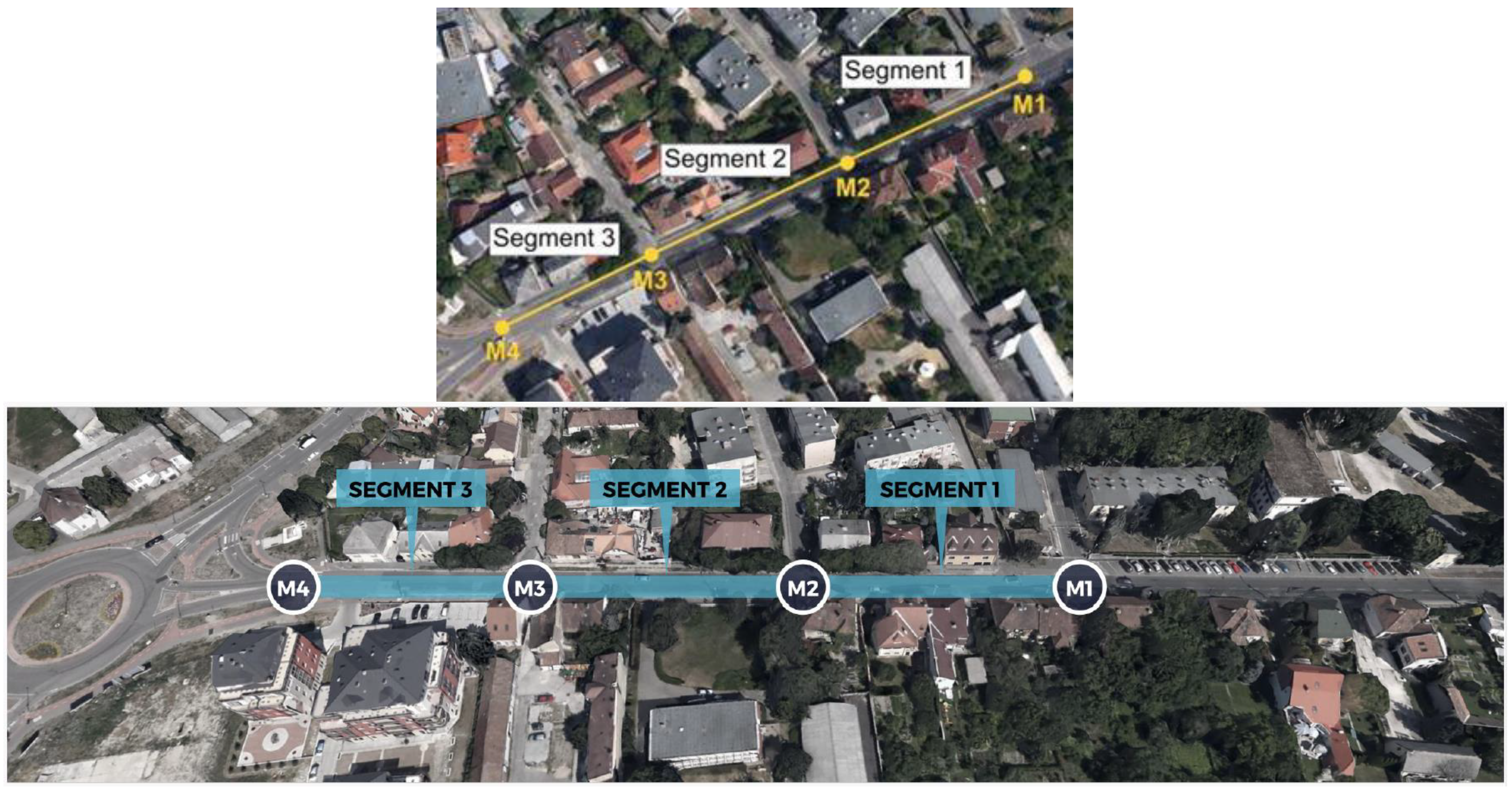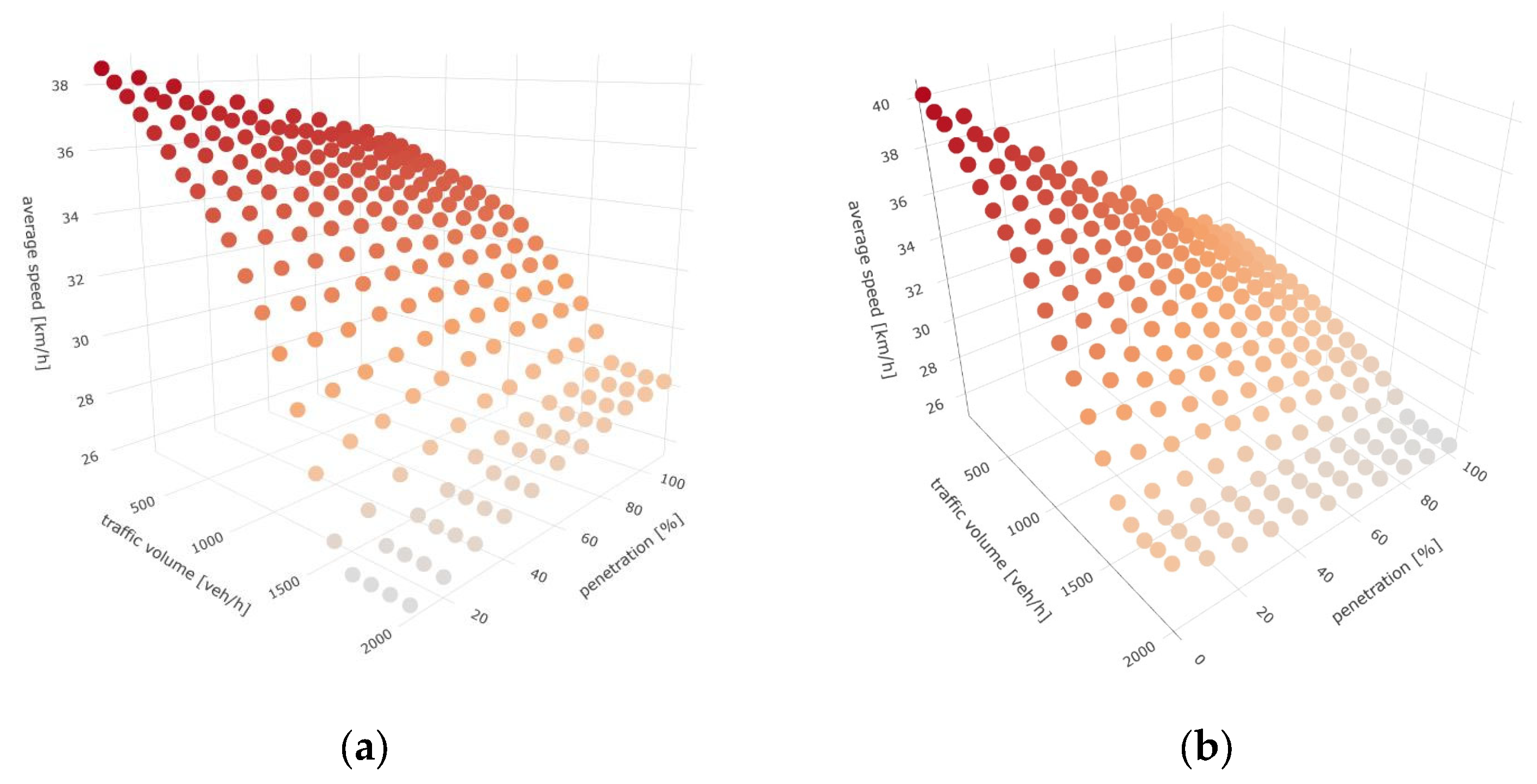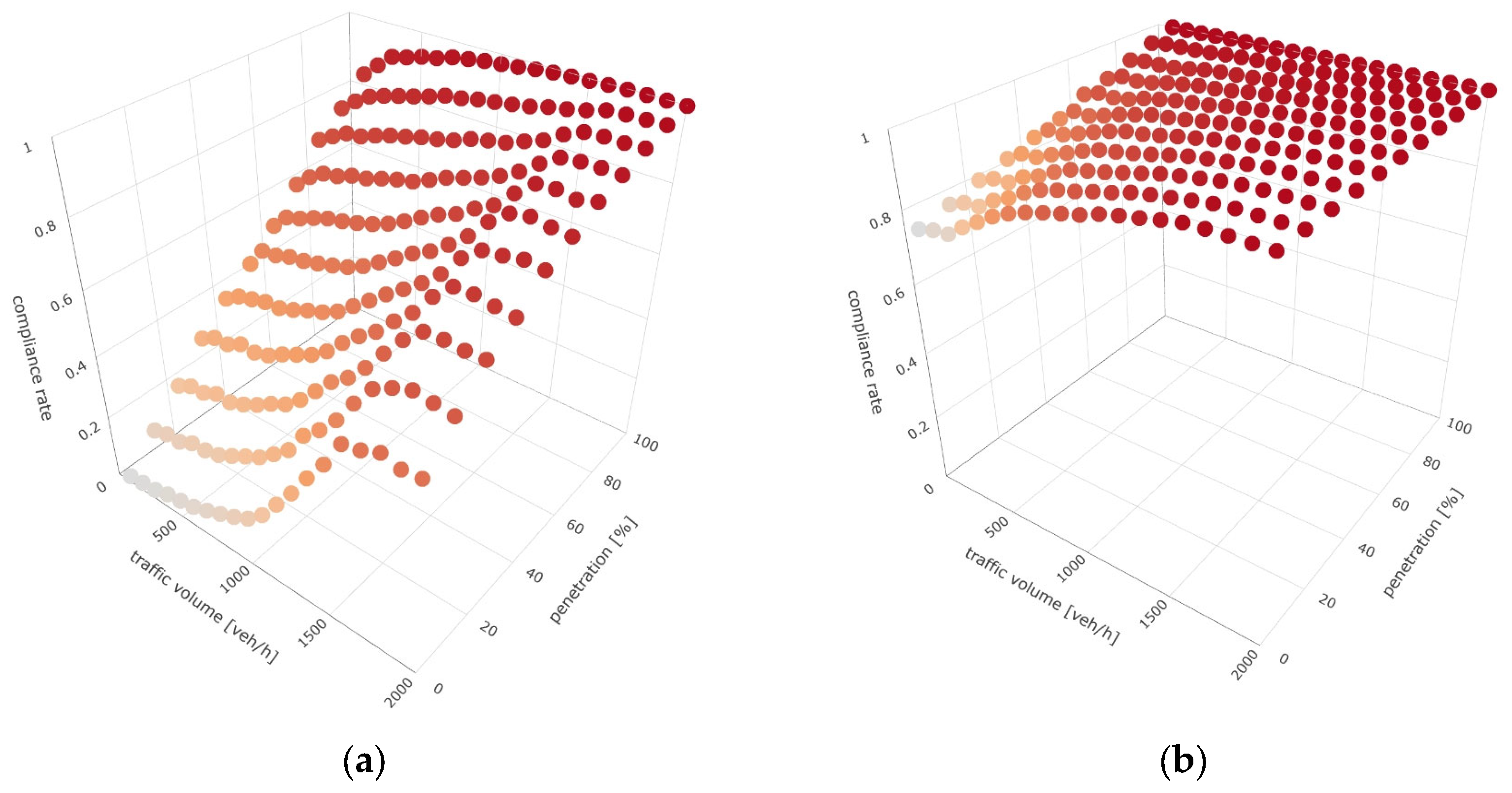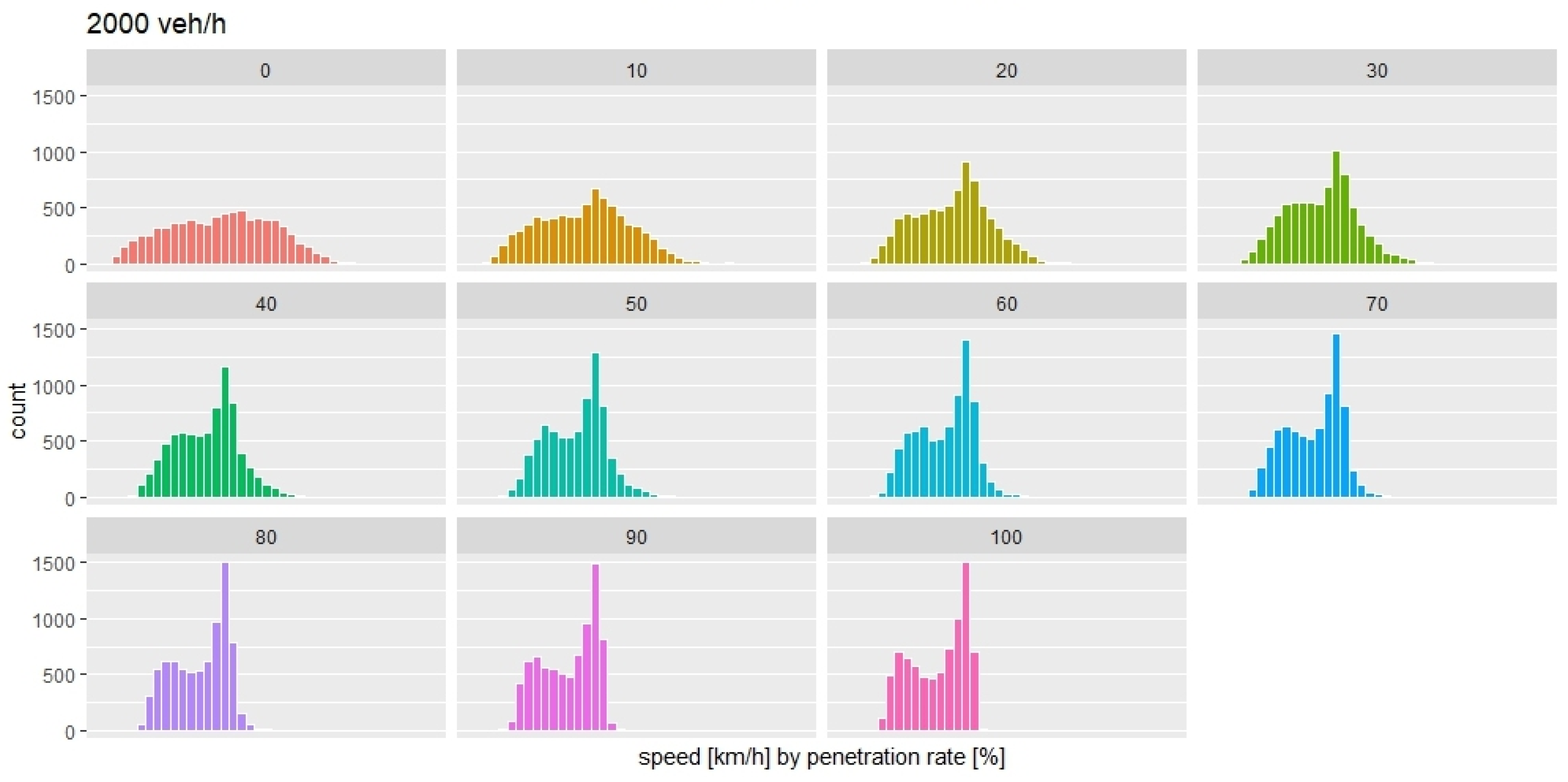1. Introduction
As the revolution of self-driving vehicles is approaching, more and more researchers are investigating the potential impacts this new technology will have on our road transportation system. Most of these studies are of the belief that autonomous vehicles (AV) will create a safer and more efficient transport infrastructure with reduced environmental impacts. However, some studies have highlighted potential issues related to the coexistence of AVs and Human Driven Vehicles (HDVs). One of these issues is how the differences in speed compliance between AVs and HDVs will affect the distribution of speeds, travel time, and speed compliance rates. This is an area where relevant research efforts are still lacking. In our study we aim to investigate the impact of the speed compliance behavior of AVs on different traffic flow performance measures by increasing their market penetration rates.
The structure of the paper is as follows. In
Section 2, a literature review is provided. Under
Section 3, data collection and methodology are introduced.
Section 4 contains results, followed by conclusions under
Section 5.
2. Literature Review
Using macroscopic traffic flow models, Friedrich [
1] came to the conclusion that a significant increase in capacity can be expected from using AVs. This increase in capacity will lead to a more efficient use of the existing transport infrastructure, a reduction in traffic jams and lost time, higher speeds, and an improvement in the quality of traffic flow [
2,
3]. Fagnant and Kockelman [
4] also argue that AVs may lead to safer roads, less congestion, and reduced parking. While these conclusions might be valid with the full market penetration of AVs, the coexistence of human-driven and autonomous vehicles will definitely generate situations that are far from idealistic.
Some researchers, for instance Schwarting et al. [
5], are of the opinion that, currently, AVs lack an understanding of human behavior requiring conservative behavior for safe operation, which leads to bottlenecks in traffic flow. This statement can be somewhat supported by accident data. Using the “Report of Traffic Accidents Involving an Autonomous Vehicle” operated by the California Department of Motor Vehicles [
6], Favaro et al. [
7] performed a detailed analysis of accidents involving AVs. In 62% of the cases, rear-end damage was recorded involving an AV being the preceding vehicle. Many of these crashes occurred because the AV behaved in an unexpected way that the human driver did not anticipate [
5], proving that drivers are not sufficiently accustomed to dynamic characteristics of AVs [
8].
Zhang et al. [
9] analyzed the impact of lag/gap acceptance behavior and the geometric design on the capacity of left-turn lanes at signalized intersections under AV mixed flow conditions. They arrived at the conclusion that if AVs strictly comply with the traffic law, the capacity of the left-turn lane will decrease by nearly 40%.
Human drivers, on the other hand, will not always comply with the traffic law. The way human drivers perceive risk whilst driving depends on the driving task and the situation, based on which they make their own speed choice. Preferred speed is a result of a trade-off between conflicting factors [
10,
11], and it will be different even for the same person under different road and environmental conditions. Gargoum et al. [
12], in their study, used a vast amount of data (35 million different observations, 600 different urban arterial and collector roads) to identify factors that influence driver compliance with speed limits. As a result of their investigation, they emphasized that establishing credible speed limits is an extremely important matter, which could have significant impacts on driver compliance. Gaca and Kiec [
13] also concluded that the desired free flow speed deviates from the speed limit and depends on road design and other factors such as time of the day.
This contradiction has been recognized by researchers, and the idea of human-like AV speed control has been investigated by a few, such as [
11,
14,
15,
16]. In a recent paper Chen et al. [
11] developed a human-like speed strategy (HC) and compared it with cruise control (CC) and road-limiting speed control (RC). The conclusion of this study is that CC and RC are, indeed, insufficient. Both strategies deviate from human driver behavior. Sharma et al. [
16] incorporated the driver compliance behavior into a connected vehicle driving strategy that can be integrated with traditional car-following models. Lu et al. [
14] proposed a personalized behavior learning system, which can learn from human drivers online based on the on-board sensing information and realize human-like longitudinal speed control.
The literature review above shows that research on human-like behavior of AVs is gaining more attention. However, very little attention has been paid to how AVs with different penetration rates would affect traffic speed and the overall speed compliance of AVs and HDVs.
3. Methods
3.1. Site Selection
An urban two-lane road section with advisory bike lanes (sharrows) on Szövetség street in the city of Győr, Hungary was selected (
Figure 1). This 350 m long section starts at 47°41′45.3″ N 17°38′05.5″ E and ends at 47°41′40.0″ N 17°37′49.6″ E. A 30 km/h reduced speed area is located in front of a kindergarten in the middle of this section. The reduced speed limit is in effect throughout the day, including weekends; however, its actual effect would be important in the morning and afternoon hours when parents drop off and pick up their children. The majority of drivers are local, who are aware of the rationale behind the speed limit.
3.2. Speed Measurements
In order to investigate the speed choice of road users, speed measurements were taken under free flow conditions [
17,
18]. Video footage was recorded; the camera was placed in the center island of the roundabout at the end of Segment 3, mounted at a height so that it could cover all the three segments. Data were recorded in the morning after 10 am on a normal day with good weather conditions. A sample of 80 cars was observed.
The measured speed data (
Table 1) prove that under free-flow conditions the speed limit sign of 30 km/h has no or very limited effect. This is, on the one hand, due to the composition of road users being familiar with the location and, on the other hand, due to the road design not implying the speed restriction.
3.3. Simulation
The speed distributions of the real-life measurements of the three sections were used as input for the simulation in PTV Vissim. Different market penetration rates (MPR) and traffic volumes were used in the simulation. MPRs ranged from 0 to 100 with an incremental increase of 10% (11 categories); traffic volumes ranged from 100 to 2000 veh/h with an incremental increase of 100 veh/h (20 categories). This resulted in a matrix of 220 cells. For each cell, 5 model runs with different random seeds were run. Each run lasted 1 h, resulting in a total of 1100 h of simulation. In the simulation, a 15 min warming period was used.
4. Results and Discussion
As a first step of our analysis, we plotted the average speed as well as average travel time vs. traffic volume and penetration rate for the entire section. This was followed by separate investigations of the individual sections. Finally, the speed compliance rate was investigated by section.
4.1. Average Speed and Travel Time
The average speed is affected by the presence of AVs [
2,
3], which we plotted for the whole section in
Figure 2a, and for Segment 2 in
Figure 2b. Based on these plots, the following observations can be made:
Under low traffic flow conditions (<1200 veh/h), as traffic flow and MPR increase, the average speed tends to decrease simply because more vehicles will stick to the speed limit. At 1200 veh/h, dots show a linear pattern, implying that MPR has no effect at all. In other words, below 1200 veh/h, a higher share of AVs actually worsen the average speed values as well as average travel time (
Figure 2a).
Under medium traffic flow conditions (1200–1700 veh/h), as traffic volume increases further, average speed further decreases; however, as the MPR increases, it can slightly compensate for the loss in average speed by increasing it (
Figure 2a).
Under high traffic flow conditions (>1700 veh/h), as traffic volume increases further at zero MPR, no real effect is visible, and the average speed remains at a stable low level. However, as MPR increases, it can slightly increase the average speed and lower the average travel time (
Figure 2a).
Figure 2b illustrates that if the speed limit is lower than the observed average, MPR lowers the average speed, irrespective of traffic volumes.
4.2. Speed Compliance
The speed compliance of vehicles is simply measured by the proportion of vehicles that obey the traffic rules. In
Figure 3, compliance rates are plotted against average speed and traffic volumes on Segments 1 and 2. Based on these figures, the following observations can be made:
For Segment 2, with a speed limit of 30 km/h, compliance starts to increase from a very low figure with low traffic volumes, i.e., almost no vehicles adhere to the rules. As the MPR increases, more and more vehicles are forced to drive below the speed limit and, hence, the compliance rate reaches 100%. The introduction of AVs also brings about more homogeneous speeds as the right tail of the speed distribution disappears and concentrates around the speed limit (see
Figure 4).
For Segment 1, with a speed limit of 50 km/h, the compliance rate is already high at low traffic volumes, simply because the speeds observed are lower than the speed limit. The effect of MPR is marginal under such circumstances.
5. Conclusions
In our study, we investigated the effect of speed compliance behavior of AVs using real-life measurements on an urban road section with a speed limit of 50 km/h, including a segment with a speed limit of 30 km/h. Speed distributions of our measurements were fed into a Vissim microsimulation model where we gradually increased the traffic volume and the market penetration rate of AVs.
Human drivers’ speed choice can deviate from the actual speed limits, which is what we observed on the 30 km/h road segment. However, AVs are expected to obey the rules and, therefore, cause unexpected changes in the average speed, travel time, and speed compliance. In our analyses, we found that under low traffic flow conditions, the increase in MPR will lead to a decrease in the average speed and worsening of the average travel time. Under medium traffic flow conditions, a high MPR can compensate for some of the travel time loss by slightly increasing average speed. As we reach saturated conditions and a high share of AVs is achieved, AVs can actually bring stability to the system and even improve average speed and decrease travel time.
The effect of AVs on speed compliance can be meaningfully interpreted on segments where actual driving speeds are above the speed limit. In our case, Segment 2, with a 30 km/h speed limit, showed a very low initial compliance rate, which could be improved to 60% by increasing the traffic volume to reach saturated conditions. Reaching a higher level of compliance was, however, only possible with the introduction of AVs, where even under low traffic volume conditions the gradual increase in the share of AVs show significant improvement in speed compliance.
Our research highlights the need for the investigation of such locations, where road design and speed regulations are not in harmony with each other. With the introduction of AVs, these locations can cause both safety and capacity issues, simply because the behavior of AVs will be different from that of human drivers. A potential further research direction is to identify these situations and analyze the impact of the presence of AVs on average speed, travel time, and speed compliance.
Author Contributions
Conceptualization, B.H. and A.B.; methodology, R.H. and V.N.; software, V.N.; validation, V.N. and A.B.; formal analysis, A.B.; investigation, A.B.; resources, B.H.; data curation, R.H.; writing—original draft preparation, A.B. and B.H.; writing—review and editing, A.B. and B.H.; visualization, A.B.; supervision, A.B. and B.H.; project administration, A.B.; funding acquisition, B.H. All authors have read and agreed to the published version of the manuscript.
Funding
This research received no external funding.
Institutional Review Board Statement
Not applicable.
Informed Consent Statement
Not applicable.
Data Availability Statement
Data for the study is available upon request from the corresponding author.
Conflicts of Interest
The authors declare no conflicts of interest.
References
- Friedrich, B. The Effect of Autonomous Vehicles on Traffic. In Autonomous Driving; Springer: Berlin/Heidelberg, Germany, 2016; pp. 317–334. [Google Scholar] [CrossRef]
- Pan, Y.; Wu, Y.; Xu, L.; Xia, C.; Olson, D.L. The impacts of connected autonomous vehicles on mixed traffic flow: A comprehensive review. Physica A 2024, 635, 129454. [Google Scholar] [CrossRef]
- Chen, B.; Chen, Y.; Wu, Y.; Xiu, Y.; Fu, X.; Zhang, K. The Effects of Autonomous Vehicles on Traffic Efficiency and Energy Consumption. Systems 2023, 11, 347. [Google Scholar] [CrossRef]
- Fagnant, D.J.; Kockelman, K. Preparing a nation for autonomous vehicles: Opportunities, barriers and policy recommendations. Transp. Res. Part A Policy Pract. 2015, 77, 167–181. [Google Scholar] [CrossRef]
- Schwarting, W.; Pierson, A.; Alonso-Mora, J.; Karaman, S.; Rus, D. Social behavior for autonomous vehicles. Proc. Natl. Acad. Sci. USA 2019, 116, 24972–24978. [Google Scholar] [CrossRef] [PubMed]
- California Department of Motor Vehicles. Reports of Traffic Accidents Involving an Autonomous Vehicle—OL316; California Department of Motor Vehicles: Los Angeles, CA, USA, 2017.
- Favarò, F.M.; Nader, N.; Eurich, S.O.; Tripp, M.; Varadaraju, N. Examining Accident Reports Involving Autonomous Vehicles in California. PLoS ONE 2017, 12, e0184952. [Google Scholar] [CrossRef] [PubMed]
- Petrovic, D.; Mijailovic, R.; Pešic, D. Traffic Accidents with Autonomous Vehicles: Type of Collisions, Manoeuvres and Errors of Conventional Vehicles’ Drivers. Transp. Res. Procedia 2020, 45, 161–168. [Google Scholar] [CrossRef]
- Zhang, X.; Wang, Y.; Nakamura, H.; Liu, K. Analysis of left-turn lane capacity under autonomous vehicle mixed flow considering the influence of pedestrian volume and crosswalk length. Asian Transp. Stud. 2022, 8, 100070. [Google Scholar] [CrossRef]
- Tarko, A.P. Modeling drivers’ speed selection as a trade-off behavior. Accid. Anal. Prev. 2009, 41, 608–616. [Google Scholar] [CrossRef] [PubMed]
- Chen, Z.; Wang, X.; Guo, Q.; Tarko, A. Towards human-like speed control in autonomous vehicles: A mountainous freeway case. Accid. Anal. Prev. 2022, 166, 106566. [Google Scholar] [CrossRef] [PubMed]
- Gargoum, S.A.; El-Basyouny, K.; Kim, A. Towards setting credible speed limits: Identifying factors that affect driver compliance on urban roads. Accid. Anal. Prev. 2016, 95, 138–148. [Google Scholar] [CrossRef] [PubMed]
- Gaca, S.; Kiec, M. Impact of Human Factor on Speed Choice. In Proceedings of the 2015 6th IEEE International Conference on Cognitive Infocommunications (CogInfoCom), Gyor, Hungary, 9–21 October 2015; pp. 527–532. [Google Scholar] [CrossRef]
- Lu, C.; Gong, J.; Lv, C.; Chen, X.; Cao, D.; Chen, Y. A Personalized Behavior Learning System for Human-Like Longitudinal Speed Control of Autonomous Vehicles. Sensors 2019, 19, 3672. [Google Scholar] [CrossRef] [PubMed]
- Zhang, Y.; Sun, P.; Yin, Y.; Lin, L.; Wang, X. Human-Like Autonomous Vehicle Speed Control by Deep Reinforcement Learning with Double Q-Learning. In Proceedings of the 2018 IEEE Intelligent Vehicles Symposium (IV), Changshu, China, 26–30 June 2018; pp. 1251–1256. [Google Scholar] [CrossRef]
- Sharma, A.; Zheng, Z.; Bhaskar, A.; Haque, M.M. Modelling Car-Following Behaviour of Connected Vehicles with a Focus on Driver Compliance. Transp. Res. Part B Methodol. 2019, 126, 256–279. [Google Scholar] [CrossRef]
- Horvath, R. Effects of the Autonomous Vehicle on Road Capacity. In Proceedings of the X. International Conference on Transport Sciences, Győr, Hungary, 29–30 October 2020. Paper: A07. [Google Scholar]
- Horvath, B.; Nagy, V.; Horvath, R. Human Driver vs. Self-Driving Vehicles from the Viewpoint of the Compliance Behaviour. In Proceedings of the 12th IEEE International Conference on Cognitive Infocommunications (CogInfoCom 2021), Győr, Hungary, 23–25 August 2021; IEEE. 2021; pp. 287–291. [Google Scholar]
| Disclaimer/Publisher’s Note: The statements, opinions and data contained in all publications are solely those of the individual author(s) and contributor(s) and not of MDPI and/or the editor(s). MDPI and/or the editor(s) disclaim responsibility for any injury to people or property resulting from any ideas, methods, instructions or products referred to in the content. |
© 2024 by the authors. Licensee MDPI, Basel, Switzerland. This article is an open access article distributed under the terms and conditions of the Creative Commons Attribution (CC BY) license (https://creativecommons.org/licenses/by/4.0/).










